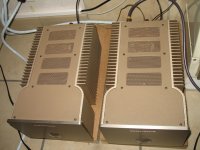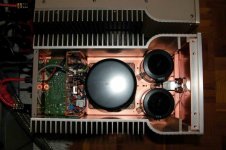When I have difficulty understanding something, I usually
keep it in front of me until I absorb it through osmosis.
😎
keep it in front of me until I absorb it through osmosis.
😎
i guess the language is confusing me, because to me power is an absolute measurement, you can have 4 times the drive, but only because the load is halved, there is not magically 4 times te available power when you have only doubled it. at least if there is there is something i'm missing.
Sorry if someone has already answered this.
P=V^2/r, Therefore if you double the voltage you quadruple the power. I am not sure if that has answered your question.
Also you get less class A current. That is you get half the class A current compared to a regular F5 biased in the same manner.
if you want 100% pure classA, it seems to me that both low impedance speakers and balanced design is a bit of a 'pain'
I agree with that, but I would also argue that you don't need 100% pure class A.
If you can bias for 20W to 30W in Class A and the rest coming from class B, then I think most people will be more than satsfied with that.
In order to (try to) be forgiven, i produce this drawing.
When the current in AD branch reaches 2xIbias ( or total bias)
The current into BC branch has decreased to 0A.
This agrees with my simulated results.
I agree with that, but I would also argue that you don't need 100% pure class A.
If you can bias for 20W to 30W in Class A and the rest coming from class B, then I think most people will be more than satsfied with that.
ahh, yes
and that we do
but why do I get a reminder of old days when some amps were 'marketed' with their 'music wattage' 😱
hey, Im not trying to be sarchastic, not at all, and I know it may not be quite the same thing
but I still get this..hmmm
but hey, Im doing it too




Just for clarification. If you think you need 100W then use the appropriate rail voltage, but only bias 20W for your known load (eg 5Ohms).
So you have the voltage to drive 100W max and the current to deliver 20W class A.
I am sure everyone can do the maths on that one now.😎
So you have the voltage to drive 100W max and the current to deliver 20W class A.
I am sure everyone can do the maths on that one now.😎
naah ....... do not disturb
I'm in a middle of osmosis process .
in fact - I'm entire life in that status .

I'm in a middle of osmosis process .
in fact - I'm entire life in that status .

if you want 100% pure classA, it seems to me that both low impedance speakers and balanced design is a bit of a 'pain'
With MOSFET output stages, balanced is always a bit of a pain, Class A or no Class A.
For low impedance loads, Class A is a bit of a pain only if the LSP also has low efficiency.
Plenty examples of high quiescent current level, low power Class A amps for high efficiency loudspeaker systems, both commercial and non-commercial designs.
ZM, stop spitting against the paper.
That's because you cannot sell a 20Kg amplifier costing 5.000$ by advertising their "just" 25w per channel.ahh, yes
and that we do
but why do I get a reminder of old days when some amps were 'marketed' with their 'music wattage' 😱
hey, Im not trying to be sarchastic, not at all, and I know it may not be quite the same thing
but I still get this..hmmm
but hey, Im doing it too
Other mainstream manufacturers choose to say the real ratings, but they seem so small that use to show them in a shy and small thypography.
Yes, you can, if you identify your market and tailor your output to satisfy that market.That's because you cannot sell a 20Kg amplifier costing 5.000$ by advertising ........25w per channel.
A bit like JC did with the Blowtorch.
That's because you cannot sell a 20Kg amplifier costing 5.000$ by advertising their "just" 25w per channel.
22KG the pair, at roughly $5000 in the early '90s, for 30W Class A power per channel.

Quite a few sold, actually.
(Oh Dear, these were used Bridged, and MOSFET output stage amps on top of that !)
Attachments
Last edited:
Sorry if someone has already answered this.
P=V^2/r, Therefore if you double the voltage you quadruple the power. I am not sure if that has answered your question.
Also you get less class A current. That is you get half the class A current compared to a regular F5 biased in the same manner.
yes that answers it perfectly thanks, joules law yes? but how does this fit with ohms law over a set resistance?
nvm, i've been too stuck on ohms law, but we are dealing with reactive devices here and the effect of increased voltage over the fets and speaker is not linear.
back to the books
22KG the pair, at roughly $5000 in the early '90s, for 30W Class A power per channel.
Quite a few sold, actually.
(Oh Dear, these were used Bridged, and MOSFET output stage amps on top of that !)
you really like them ......
...
Look Ma, no spaghetti.
Actually, I prefer straight, short and thick piece of wire instead of false tidiness of endless spaghetti tracks on the pcb... 😛
yes that answers it perfectly thanks, joules law yes? but how does this fit with ohms law over a set resistance?
nvm, i've been too stuck on ohms law, but we are dealing with reactive devices here and the effect of increased voltage over the fets and speaker is not linear.
back to the books
Ok to make it simple lets assume no losses.
The best way to do this is with an example.
We have two amps:
A) Stock standard F5 with 20V rails
B) Balanced F5 with 20V rails
Assuming no losses:
the max power of amp A is (20^2)/8 = 50W pk (25W avg) power into 8 Ohms
the max power of amp B is (40^2)/8 = 200W pk (100W avg) power into 8 Ohms.
To determine required current use V=IR or I=V/R
Amp A requires 20/8 A = 2.5A for max Class A power (ie 25W avg) into 8 Ohms, however we only need to bias at 2.5/2 = 1.25A since a push pull amp provides double the bias current
Amp B requires 40/8 A = 5A for max Class A power (ie 100W avg) into 8 Ohms, however the balanced F5 does not provide double the bias so we need to bias at 5 A (thats 2.5A from each half of the circuit)
So a balanced F5 will produce 4 x the power of a regular F5 using the same rail voltages, but depending on the bias current it may not all be in Class A.
There is no reason why you couldn't build a Balanced F5 with 20V rails and a bias current of 2.5A. That will give you 25W Class A and up to 100W in class B.
Hope that all makes sense.
20V rails
I think you mean 24v rails, 20v available.
Amp B requires 40/8 A = 5A for max Class A power (ie 100W avg) into 8 Ohms, however the balanced F5 does not provide double the bias so we need to bias at 5 A (thats 2.5A from each half of the circuit)
That's two output pairs
Last edited:
- Status
- Not open for further replies.
- Home
- Amplifiers
- Pass Labs
- Balanced F5 question

